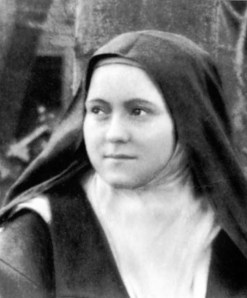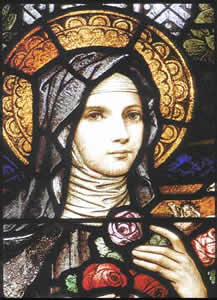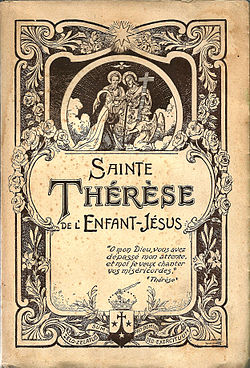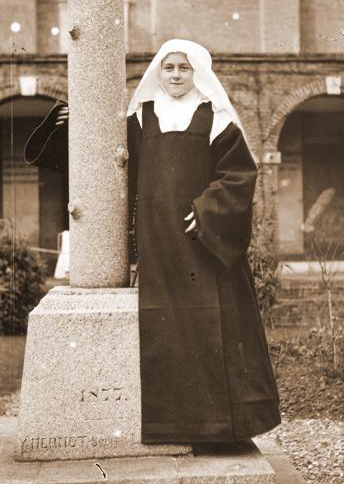 "Histoire d'une âme"  Therese Martin, about 9 years old . . Born into a devout Catholic family in Lower Normandie, in the North of France, Marie Françoise-Thérèse Martin grew up as a bright and determined little girl, with the stress on "determined". Once Therese made up her mind, she never changed, not even if punishment was threatened or administered. With Therese it was either her way, or the highway. And her parents and sisters learned to accept this. By age nine, her young life was already touched by suffering. She lost her mother when she was four, at nine her older sister, that acted as her mother, left her to join the convent. She went through a grave illness that doctors gave conflicting diagnostics for, but no cure, and her family thought they would lose her. One day she saw her sisters praying for her at a statue of the Virgin Mary, so later she also prayed at the same statue. After that she swore that she saw the Virgin Mary radiantly smiling towards her, she immediately felt better and her illness left her body by the next day! Two doctors confirmed her healing. That statue still exists and it's been nicknamed "The Virgin Mary of the Smile". At age 9 Therese knocked on the convent's door and asked to be admitted, but the prioress explained to her that she must be 21 for that. By age 15 she convinced her father to take her to Rome for an audience with Pope Leon XIII, to ask permission to enter the Carmelite convent. They went to Rome, where she was told she was not to speak to the Pope during the audience. Yeah, sure. She went straight to the Pope and, with tears in her eyes, asked for what she most wanted. And she wouldn't budge, waiting for the Pope to grant her the wanted permission - the Swiss guards had to pick her up and whisk her away. The Pope said only "Go, go, you will enter if God wills it". And obviousy God willed it, because after her return from Rome, whatever she did or did not do, still age 15, determined Therese was admitted and she entered the cloistered Order of Discalced (barefoot) Carmelites at Lisieux, Normandie, where she died in 1897 at the young age of 24. At that time, very few people, ouside of her family and her convent sisters, knew about her existence, about her life at the Carmel*, and about her passing.  “God would never inspire me with desires which cannot be realized; so in spite of my littleness, I can hope to be a saint.” Therese of Lisieux, 1873 - 1897 Yet, a short 26 years later, in 1923, Therese of Lisieux was beatified, then in 1925 canonized, by pope Pius XI, as Saint Therese of the Child Jesus and the Holly Face. Pope Pius XI considered her the star of his pontificate and, in 1927, proclaimed her Universal Patron of the Missions alongside Saint Francis Xavier. Pope Pius X considered her one of the greatest saints of the 19-th century. Therese of Lisieux is now a Secondary Patroness of France**, at the same level with Joanne D'Arc. She is also Patroness of the Vatican Gardens, with the title "Sacred Keeper of the Gardens". In 1997, at the 100-th anniversary of her death, Pope John Paul II proclaimed her "Doctor of the Church" the 33-d Doctor, only the 3-d woman thus proclaimed, and the only Doctor of the Church proclaimed by Pope John Paul II during his entire pontificate. All these because of the way Therese of Lisieux led her short yet exemplary life of extreme devotion, and, especially, for what she wrote in three manuscripts later published as a book.  “When I die, I will send down a shower of roses from the heavens, I will spend my heaven by doing good on earth.” St Therese of Lisieux Her feastday is October 1. She is affectionately known as "The Little Flower of Jesus" or, simply, "The Little Flower" she is well known around the world, her fame is only second to that of St Francis of Asissi, and the Basilica of Lisieux, built in her honor, is today the second largest place of pilgrimage in France, second only after Lourdes. I'm thinking, if St Therese of Lisieux could speak to us, and if she could speak English, she might very well say two words. "Told ya!" "The Story of a Soul", that earned her the fame and later the Sainthood, wasn't even a book, until it was assembled by her sister Pauline, also a Discalced Carmelite nun, from three autobiographical but unrelated manuscripts, written by St Therese of the Child Jesus over a short period of time, at the prodding of her Sisters and the express order of her Prioress. They knew she was on to something, having earlier listened to her telling her childhood and later stories!  1940 Edition of "Histoire d'une âme" Printed originally in only 2,000 copies, exactly one year after her death, The Story of a Soul soon became a resounding success, a real publishing phenomenon. To date it was translated in 50 languages, many editions were printed, totalling some 500,000,000 copies! It is considered a mystical book, it was adapted for a number of theater and film productions, and earned the 1989 French Academy Award. It influenced and changed the lives of many people, some of them, in turn, also being beatified by the Catholic Church. So what can possibly be in this book, to make the whole Catholic world, from Popes on down, go bonkers for Therese of Lisieux and her writings? From her simple childhood and later stories springs a new, revolutionary yet uncontested theology, the theology of a child that yearns to be in communion with God, loves God, and loves His creation. Something that Therese calls "The Little Way" ("La Petite Voie") describing a straight, direct, short way of achieving communion with God, also known as the "Little Way of Spiritual Childhood". That's not all, but that's the essence of it, and it was obviously more than enough. “Without love, deeds, even the most brilliant, count as nothing.”
Therese of Lisieux You can read this book, should you be interested, there are links at the bottom of this page for the English and French versions. There's no copyright on this book, so you can download and copy or print all you can or want. Amazon has it too. By the way, the "soul" title of the book was given by her sister at publication. The original title that Therese of Lisieux gave to the main part of the three autobiographical manuscripts that the book consists of was simply "Springtime Story of a Little White Flower" ("Histoire Printaniere d'une Petite Fleur Blanche"). Imagine that! What amazing people once lived on this Earth! More about this book and its story here. Links to biography and more, in the page: https://en.wikipedia.org/wiki/The_Story_of_a_Soul A more detailed page about it, if you understand French: (En Français) https://fr.wikipedia.org/wiki/Histoire_d%27une_%C3%A2me_(Th%C3%A9r%C3%A8se_de_Lisieux) The page for St. Therese of Lisieux, in English, on the Vatican Web-site: http://www.vatican.va/news_services/liturgy/saints/ns_lit_doc_19101997_stherese_en.html Read "The Story of a Soul" in English, audio book also available, here: http://www.storyofasoul.com/ And in French, here: http://livres-mystiques.com/partieTEXTES/Lisieux/Histoire/table.html Read, print, or download the book in English, in PDF format here: storyofasoul.pdf  At the Lisieux Carmel * A Carmelite Monastery, or Convent, named for Mt. Carmel in Israel, is vernacularly referred to as a "Carmel". ** The Primary Patroness of France is The Virgin Mary (as Our Lady of the Assumption). Back to The Blind Stork
__oOo__ Information and photos from the Internet, Text © Copyright - The Blind Stork, 2016 |